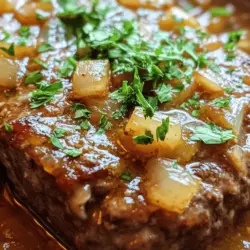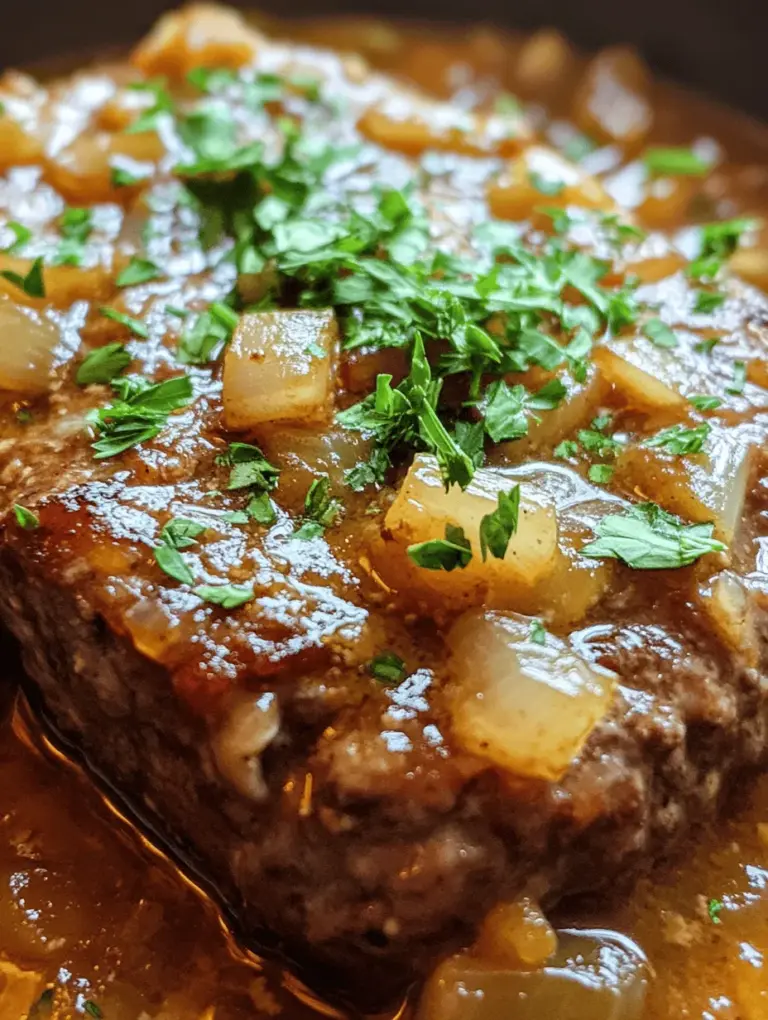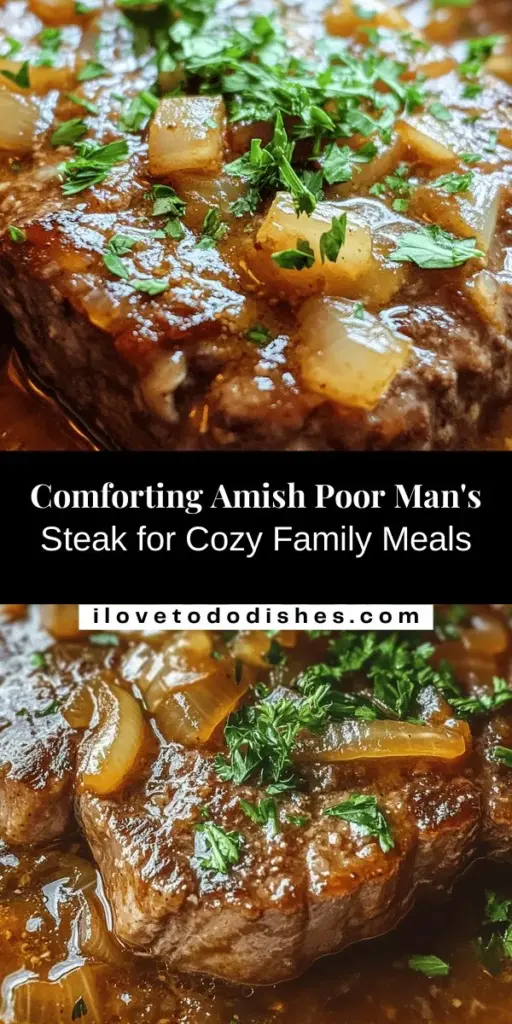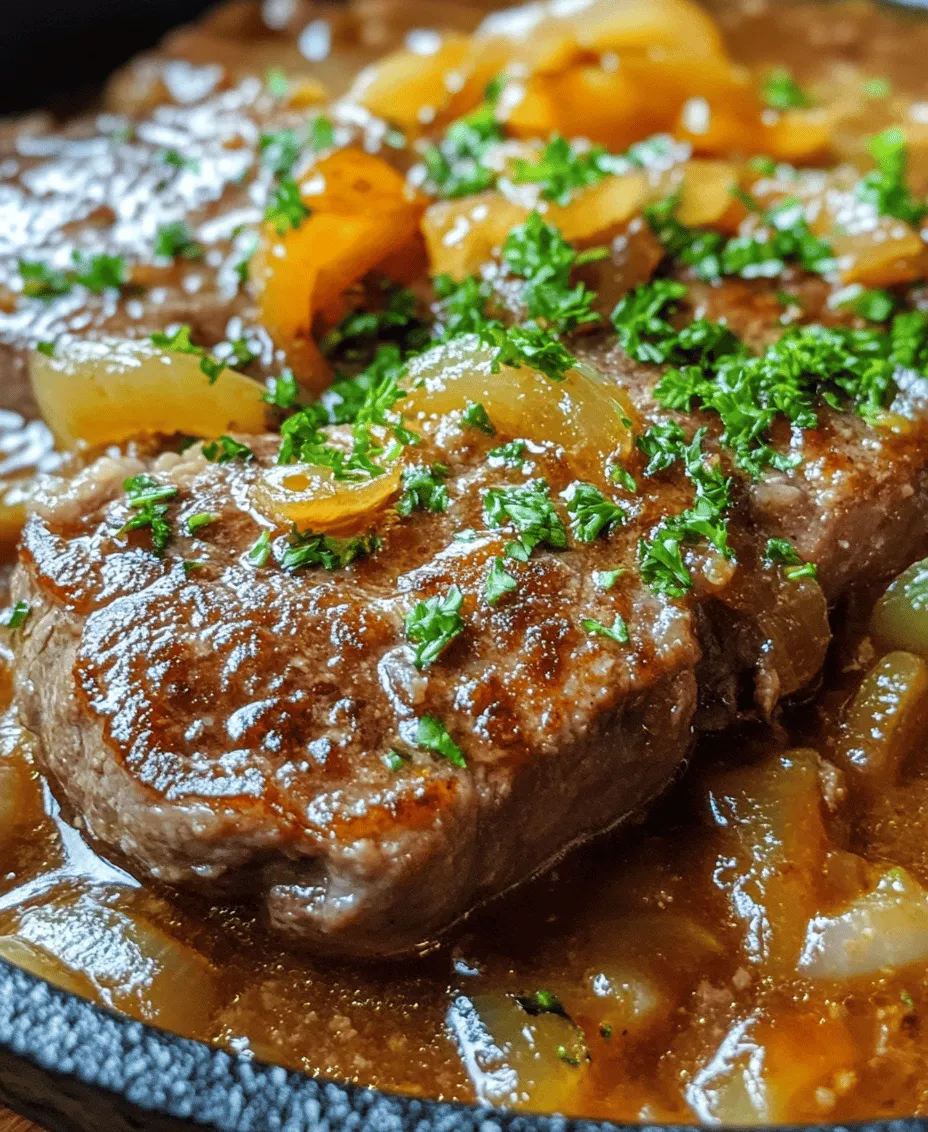Amish Poor Man’s Steak is a dish that resonates deeply within the heart of Amish cooking, celebrated for its simplicity, heartiness, and comforting flavors. This recipe, which has been passed down through generations, reflects the resourcefulness and culinary traditions of the Amish community. In an age where extravagant meals often steal the spotlight, this dish stands out for its straightforward approach to creating a satisfying meal using minimal ingredients. It is more than just a meal; it’s a representation of a lifestyle that values practicality and community.
The Origins of Amish Poor Man’s Steak
Rooted in the Amish way of life, Poor Man’s Steak was created as an economical yet filling dish that could serve families without breaking the bank. The Amish, known for their agricultural practices and self-sufficient lifestyle, often utilize the ingredients readily available to them. This recipe illustrates their knack for transforming humble cuts of meat into a delicious and hearty meal. The dish typically features a budget-friendly cut of steak, which is marinated and then coated in a flavorful blend before frying, making it a favorite among those who cherish both flavor and frugality.
The name “Poor Man’s Steak” may suggest a lack of sophistication, but it belies the dish’s rich flavors and satisfying nature. The incorporation of simple ingredients like buttermilk and spices elevates the dish, providing a depth of taste that makes it a cherished staple at family gatherings and comfort food dinners alike. Whether served with mashed potatoes, fresh vegetables, or a side salad, this dish offers a warm embrace of flavors that is perfect for any occasion.
The Comforting Nature of the Recipe
One of the most appealing aspects of Amish Poor Man’s Steak is its comforting nature. In a world filled with fast-paced meals and elaborate culinary trends, this dish brings back the essence of home-cooked meals—those that warm your heart and nourish your body. The tender meat, combined with a crispy coating and rich gravy, creates a dish that is both satisfying and nostalgic. Many home cooks find joy in preparing this meal, as it reminds them of family gatherings and hearty Sunday dinners.
The beauty of this recipe lies in its ability to create a sense of belonging and warmth within the home. The aromas that waft from the kitchen while the steak cooks evoke memories of shared meals and laughter around the dinner table. It’s a dish that invites togetherness, making it perfect for family gatherings or cozy nights in.
Simplicity and Accessibility of Ingredients
Amish Poor Man’s Steak is not only comforting but also remarkably simple and accessible. The ingredients required are often staples in many households, making it easy for anyone to whip up this delightful dish. By relying on affordable cuts of meat and common pantry items, this recipe is ideal for home cooks looking for a satisfying meal without the fuss.
The main ingredient, steak, can be found at any grocery store or butcher shop, and the accompanying components—such as buttermilk, flour, and spices—are generally readily available. This ease of access makes Amish Poor Man’s Steak an excellent choice for those who may be new to cooking or for busy families looking for a quick weeknight dinner.
Understanding the Ingredients
To truly appreciate Amish Poor Man’s Steak, it’s essential to delve into the ingredients that make this dish so special. Each component plays a critical role in delivering the flavors and textures that define this comforting meal.
Main Ingredient: Steak
The primary ingredient in Poor Man’s Steak is, of course, the steak itself. Typically, this dish features either round steak or cubed steak, both of which are economical cuts of meat. Understanding the differences between the two can help you make the best choice for your dish.
Round Steak vs. Cubed Steak:
– Round Steak: This cut comes from the rear leg of the cow and can be quite tough if not prepared correctly. However, it’s an excellent choice for this recipe as it absorbs flavors well when marinated and can become tender with appropriate cooking methods.
– Cubed Steak: This is usually round steak that has been tenderized and flattened. It is often pounded with a meat mallet or run through a mechanical tenderizer. Cubed steak is convenient for this dish as it cooks quickly and is typically more tender than round steak.
Choosing the right cut is essential for achieving the desired tenderness. When shopping for steak, look for cuts that have a good balance of meat and fat, as the fat will help keep the meat juicy during cooking.
Marinade: The Role of Buttermilk
One of the standout features of Amish Poor Man’s Steak is its marinade, which primarily consists of buttermilk. This ingredient is not only a common staple in Amish kitchens but also a culinary secret that enhances the dish significantly.
Importance of Buttermilk:
Buttermilk is a magical ingredient when it comes to tenderizing meat. The lactic acid in buttermilk breaks down proteins, allowing the meat to become more tender and flavorful. This process is particularly important for tougher cuts of steak, making buttermilk an ideal marinade component.
Benefits of Marinating Meat:
Marinating not only imparts flavor but also improves the texture of the meat. For this recipe, marinating the steak in buttermilk for several hours or overnight ensures that it absorbs the flavors and becomes incredibly tender. It’s a simple step that pays off in the final dish, resulting in juicy, flavorful steak that is the star of the meal.
Seasoning and Coating
The seasoning and coating are what elevate this dish from simple steak to a delicious meal. The combination of flour and a carefully selected seasoning blend enhances the overall flavor profile.
Importance of Flour and Seasoning Blend:
The flour serves as a base for the coating, providing a crispy texture when the steak is fried. However, it’s the seasoning blend that truly transforms the dish. A mix of garlic powder, onion powder, and paprika adds depth and complexity to the flavors.
Role of Garlic Powder, Onion Powder, and Paprika:
– Garlic Powder: Adds a rich, savory flavor that complements the meat beautifully.
– Onion Powder: Provides a slight sweetness and enhances the overall depth of flavor.
– Paprika: Contributes a hint of smokiness and vibrant color to the dish.
Using a generous amount of seasoning ensures that every bite is packed with flavor, making the steak irresistible.
Cooking Fat: Vegetable Oil
For frying the steak, vegetable oil is a common choice. It has a high smoke point, which makes it ideal for achieving that perfect crispy exterior without burning.
Choice of Cooking Oil for Frying:
While vegetable oil is the traditional choice, you can also experiment with other oils like canola or peanut oil, both of which work well for frying. If you’re looking for healthier alternatives, consider using avocado oil or light olive oil, which can add unique flavors while maintaining a high smoke point.
Supporting Ingredients
In addition to the star ingredients, there are supporting elements that round out the dish and enhance its flavor.
Importance of Onions and Broth:
Onions add sweetness and complexity to the dish, while broth adds moisture and richness. When preparing Amish Poor Man’s Steak, sautéing onions in the same pan after frying the steak allows them to absorb the leftover flavors, creating a delicious base for the gravy.
Options for Garnishing and Serving:
This dish can be garnished with fresh herbs or served alongside mashed potatoes, green beans, or a simple salad. The versatility of Poor Man’s Steak allows you to tailor your sides to your preference, making it a flexible option for any meal.
Step-by-Step Preparation Guide
Now that we’ve covered the essential ingredients, it’s time to dive into the preparation process. A few key steps will ensure that your Amish Poor Man’s Steak turns out perfectly every time.
Tenderizing the Steak
The first step in preparing this dish is tenderizing the steak, which is crucial for achieving the desired texture.
Techniques for Achieving the Right Thickness:
If you’re using round steak, it may require some additional work to ensure it’s tender. Here are a couple of techniques you can use:
– Pounding: Use a meat mallet to gently pound the steak to an even thickness. This process breaks down the fibers and helps the meat cook more evenly.
– Slicing: If you prefer, you can slice the round steak into thinner pieces. This not only reduces cooking time but also increases tenderness.
Tips for Seasoning Effectively:
Once your steak is the right thickness, season it generously with salt and pepper before marinating. This initial seasoning step allows the flavors to penetrate the meat, enhancing its overall taste.
Marinating Process
The marinating process is where the magic happens. Proper marination is key to achieving tender, flavorful steak.
Best Practices for Marinating Time and Temperature:
– Time: For optimal results, marinate your steak for at least 2 hours, or up to 24 hours if time permits. The longer the steak sits in the buttermilk, the more tender it will become.
– Temperature: Always marinate in the refrigerator to prevent any bacterial growth. If you’re short on time, even a quick 30-minute soak can provide some benefits.
How Marinating Influences Flavor and Texture:
As the steak marinates, the buttermilk works its magic, tenderizing the meat and infusing it with flavor. When cooked, the result is a juicy, tender steak with a crispy, flavorful coating that will leave your taste buds singing.
By following these initial steps and understanding the importance of each ingredient, you’ll set the stage for a delicious Amish Poor Man’s Steak that is sure to impress family and friends alike. This dish is not only a testament to Amish cooking traditions but also a reminder of the joy that comes from sharing a hearty meal with loved ones.
Creating the Coating
To achieve the signature crust that defines Amish Poor Man’s Steak, you’ll start by creating a flavorful coating. This process involves mixing flour and spices to enhance the taste and texture of the steak.
Mixing the Flour and Spices
Begin by gathering your ingredients: all-purpose flour, salt, black pepper, garlic powder, onion powder, and any other spices you prefer, such as paprika or cayenne for a little heat. In a medium bowl, combine 1 cup of all-purpose flour with 1 teaspoon of salt, 1 teaspoon of black pepper, 1 teaspoon of garlic powder, and 1 teaspoon of onion powder. Feel free to adjust these quantities based on your taste preferences. Whisk these dry ingredients together until they are well blended. This mixture will not only add flavor but also create a delicious crust once fried.
Dredging the Steak
Now it’s time to properly dredge your steak for that optimal crust. Take each piece of meat and pat it dry with paper towels to remove excess moisture, which helps the flour adhere better. Dip the steak into the flour mixture, ensuring that each side is thoroughly coated. Press gently to help the flour stick, then shake off any excess. The goal is to have a light but even coating that will crisp up beautifully during frying.
Frying the Steak
Frying is a crucial step for creating that golden-brown crust on your Poor Man’s Steak. Pay attention to the following techniques and safety tips to ensure your frying goes smoothly.
Techniques for Achieving the Perfect Golden-Brown Crust
Heat a large skillet over medium-high heat and add enough oil to cover the bottom of the pan (about 1/4 inch deep). Use oils with high smoke points, like canola or vegetable oil, to prevent burning. Once the oil is hot (you can test this by dropping in a small piece of flour; if it sizzles immediately, it’s ready), carefully place the dredged steaks in the skillet. Do not overcrowd the pan; fry in batches if necessary. Fry each side for about 3–4 minutes, or until the crust is golden brown and crispy. Resist the urge to flip the steaks too soon; let them cook undisturbed for the best crust.
Safety Tips for Frying
When frying, safety is paramount. Use a splatter screen to minimize oil splatter and protect your skin. Keep a close eye on the temperature of the oil to prevent it from smoking or catching fire. Have a lid nearby to cover the pan if necessary. Always use long utensils to handle the meat, and never reach over the hot oil to avoid burns.
Caramelizing Onions
Caramelized onions add a rich, sweet flavor that beautifully complements the savory taste of the Poor Man’s Steak. Understanding the caramelization process is key to achieving the perfect onion texture.
The Caramelization Process
To caramelize onions, slice them thinly, about 1/4 inch thick. Once your steaks are cooked and removed from the skillet, lower the heat to medium and add a tablespoon of butter or oil to the same pan, scraping up any browned bits left from the steak. Add the sliced onions and a pinch of salt. Stir to coat the onions in the fat and help them cook evenly.
Avoiding Burning Onions
The key to caramelization is patience. Allow the onions to cook slowly, stirring occasionally to prevent them from burning. This process typically takes around 15 to 20 minutes. If you notice the onions sticking or browning too quickly, reduce the heat. The goal is to achieve a deep golden brown color, which enhances their natural sweetness.
Simmering to Perfection
Simmering is a critical step in developing the flavors of your dish. After adding the onions back into the pan, it’s time to incorporate the steak and simmer for a delightful melding of tastes.
Importance of Simmering for Flavor Melding
After the onions are nicely caramelized, return the fried steaks to the pan. Add beef broth or water—enough to reach halfway up the sides of the steak. Bring the mixture to a gentle simmer. Cover the pan and allow it to cook for an additional 20-30 minutes. This step not only helps the steak become tender but also allows the flavors of the onions and broth to meld beautifully.
Techniques to Scrape Up Fond for Added Depth
As the broth simmers, use a wooden spoon to scrape up any fond (the brown bits stuck to the bottom of the pan). These bits are packed with flavor and will enhance the richness of your sauce. If the fond begins to stick too much, add a splash of broth or water to help lift it.
Serving Suggestions
Presentation matters, especially for a dish as hearty as Amish Poor Man’s Steak. Here are some ideas for serving and side dishes that complement this comforting meal.
Presentation Ideas
To serve, place a steak on a plate and spoon some of the caramelized onions and sauce over the top. Consider garnishing with fresh parsley for a pop of color. A side of mashed potatoes or buttered noodles can be served to soak up the delicious gravy, creating an inviting and satisfying meal.
Suggested Side Dishes
Pair your Poor Man’s Steak with classic sides like creamy mashed potatoes, roasted vegetables, or a fresh garden salad. For a heartier option, consider serving it with homemade biscuits or cornbread, which can also soak up the flavorful sauce.
Beverage Pairing Options
To enhance your meal, consider pairing it with a robust red wine, such as Merlot or Cabernet Sauvignon, which complements the rich flavors of the steak and gravy. If you prefer non-alcoholic options, a hearty apple cider or a dark soda can also work well.
Nutritional Information
Understanding the nutritional profile of your meal can help you make informed choices while enjoying this classic dish.
Overview of the Nutritional Profile
A typical serving of Amish Poor Man’s Steak contains about 350-400 calories, depending on the size of the steak and the amount of sauce. This dish is rich in protein, with a single serving providing around 30 grams, making it a filling option for meat lovers.
Discussion on Calories, Protein, and Other Key Nutrients
In addition to protein, this dish contains essential nutrients like iron, zinc, and B vitamins, which are important for energy production and overall health. Keep in mind that while this meal is hearty, portion control is key, especially if you’re watching calorie intake.
Consideration of Dietary Variations or Substitutions
For those looking to reduce calories or make the dish more heart-healthy, consider using lean cuts of beef or substituting some of the flour with whole wheat flour for added fiber. You can also experiment with using vegetable broth instead of beef broth for a lighter version.
Cultural Significance of Amish Poor Man’s Steak
Amish Poor Man’s Steak is not just a delicious meal; it carries a rich cultural history that connects families and communities in Amish regions.
Historical Context of the Dish in Amish Communities
Originally developed as a way to stretch limited resources, this dish exemplifies the Amish philosophy of simplicity and practicality. It utilizes affordable cuts of meat and basic pantry staples, making it a staple in many Amish households.
Stories or Anecdotes Connecting the Dish to Family Gatherings
In Amish culture, meals often bring families together. Poor Man’s Steak is a common dish at family gatherings and community events, symbolizing comfort and togetherness. Many families have their own variations and stories associated with the dish, passed down through generations.
Comparison to Other Comfort Foods in American Cuisine
Similar to dishes like meatloaf and pot roast, Poor Man’s Steak embodies the essence of American comfort food. Its hearty nature and satisfying flavors make it a beloved choice across various regions, bringing warmth and nostalgia to those who enjoy it.
Conclusion
Amish Poor Man’s Steak is more than just a meal; it’s a heartwarming dish that invites connection, nostalgia, and comfort. From the detailed steps of creating a flavorful coating and frying to the caramelization of onions and the simmering process, every step enhances the dish’s appeal.
As we’ve explored the serving suggestions, nutritional information, and cultural significance, it’s evident that this dish is accessible and deeply satisfying. Whether you’re cooking for a family dinner or a special occasion, Amish Poor Man’s Steak is sure to impress.
We encourage you to try your hand at making this delightful dish. Share your experiences and any personal touches you add—there’s a sense of joy in creating and sharing meals that are rooted in tradition and love.



